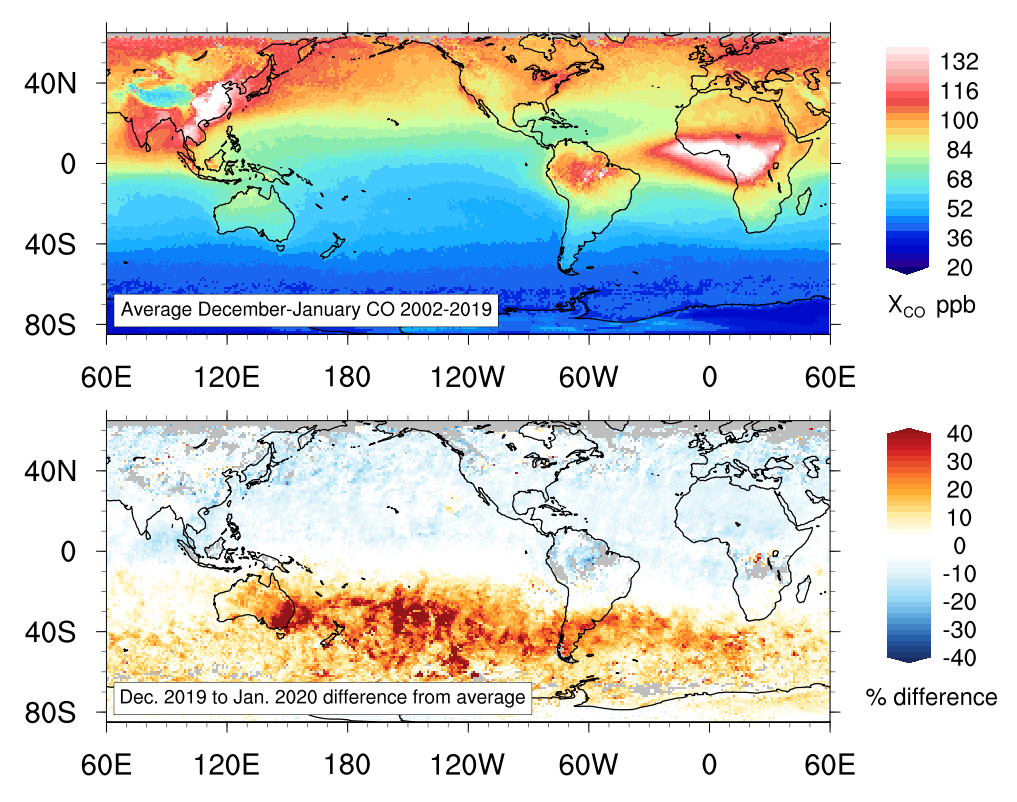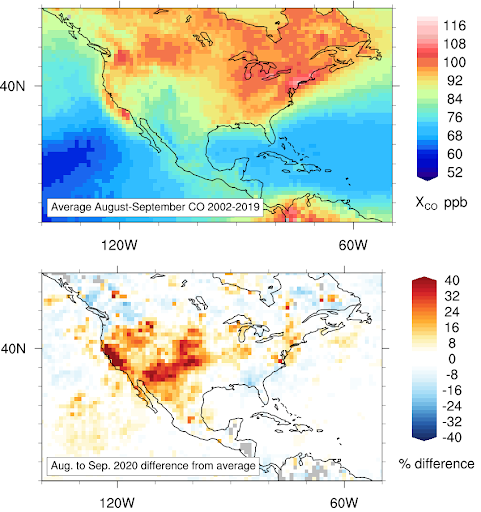MOPITT perspective of unprecedented fires in Australia and the Western US
Wildfires release large volumes of atmospheric pollution in the form of trace gases and particles. Carbon monoxide (CO) is one such trace gas emitted from fires and is measured from the satellite-based instrument Measurements Of Pollution In The Troposphere (MOPITT). More than 20 years of the MOPITT CO record allow us to place unusual events in a historical context, such as unexpectedly large fire seasons. We are studying two recent large fire seasons using MOPITT CO measurements.

Figure 1. Mean MOPITT CO, as column average volume mixing ratio (XCO), for December and January between 2002 and 2019 (top), and the percent difference of the December 2019 and January 2020 average CO relative to the long-term average (bottom). Enhancement due to the Australian fires impacts all of the Southern Hemisphere.
The unprecedented 2019/2020 East Coast Australian fire season resulted in devastating consequences for lives and property, as well as produced large emissions of fire pollution. Australian fires that burned between September 2019 and March 2020 resulted in high CO atmospheric abundances that were unmatched in the 20 year MOPITT record at Australian latitudes. Fire pollution not only impacted the regional atmosphere, but was also lofted and transported far downwind, over New Zealand and to South America. The fire emissions eventually impacted the entire Southern Hemisphere (Fig. 1). MOPITT CO combined with other satellite and ground-based instruments will be used to characterize the 3-dimensional extent and understand the chemical evolution for fire pollution plumes. This research includes an effort to determine the characteristics of several pyrocumulus events during the season that transported fire pollution to the stratosphere, where it has more potential to impact Earth’s radiative balance and consequently the climate. Observational analysis will be complemented by climate-chemistry modeling with the new regional-refinement capability in the Community Earth System Model (CESM) that allows investigation of fine-scale chemistry locally at the same time as transported pollution.
The Western US also experienced a severe fire season in the Northern Hemisphere summer and fall of 2020. Although our research has found a global average downward trend in CO using MOPITT observations (Worden et al., 2013; Buchholz et al., in review), there is a late summer upward trend in CO over the Northwest of North America that we attribute to wildfire (Buchholz et al., to be submitted). The anomalously high CO over North America during the large fire season in 2020 (Fig. 2) aligns with this increasing late summer positive trend in CO. Fire pollution in the Western US impacts not only local communities, but is transported east across the whole North American continent to potentially impact air quality in regions downwind. Overall, wildfire is becoming an increasingly important component of North American air quality considerations.

Figure 2. The percent difference of August and September 2020 average MOPITT CO relative to the long-term average. Enhancement due to the Western US fires is evident.
References
Buchholz, R. R., Worden, H. M., Park, M., Francis, G., Deeter, M. N., Edwards, D. P., Emmons, L. K., Gaubert, B., Gille, J., Martínez-Alonso, S., Tang, W., Kumar, R., Drummond, J. R., Clerbaux, C., George, M., Coheur, P.-F., Hurtmans, D., Bowman, K. W., Luo, M., Payne, V. H., Worden, J. R., Chin, M., Levy, R. C., Warner, J., Wei, Z., and S., K. S., (under review 2020), “Air pollution trends measured from Terra: CO and AOD over industrial, fire-prone, and background regions.” Remote Sensing of Environment.
Worden, H. M., Deeter, M. N., Frankenberg, C., George, M., Nichitiu, F., Worden, J., Aben, I., et al., (2013). “Decadal Record of Satellite Carbon Monoxide Observations.” Atmospheric Chemistry and Physics 13: 837–50.
Buchholz, R. R., Park, M., Worden, H. M., Tang, W., Edwards, D. P., Gaubert, B., Deeter, M. N., Sullivan, T., Ru, M., Chin, M., Levy, R. C., Zheng, B. and Magzamen, S. (to be submitted), “New seasonal pattern of pollution emerges from changing North American wildfires.”